How to Pass AI Detection Tests as an SEO Writer
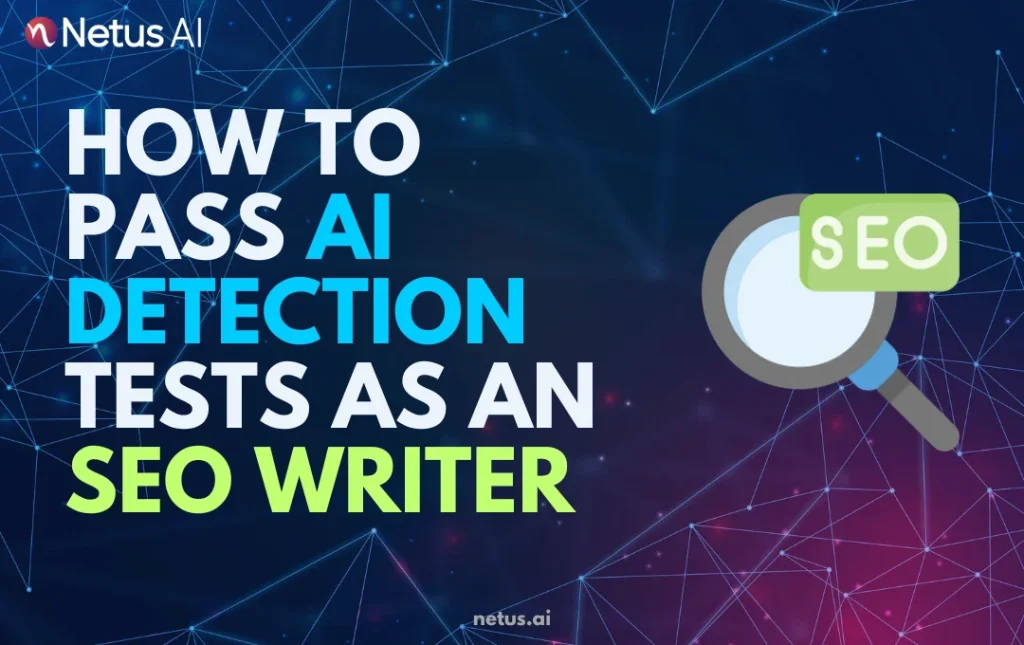
Let’s paint a familiar picture. You’ve just finished a blog post. The headline is sharp, the keywords are seamlessly integrated and the structure is flawless. A few months ago, you’d have hit ‘publish’ with confidence, expecting a steady climb up the SERPs. But now, a nagging doubt creeps in. It looks perfect but does it feel human? Could this piece, crafted with the help of powerful AI, be silently flagged by the very algorithms you’re trying to impress? This isn’t paranoia; it’s the new reality for the modern SEO writer. The game has evolved beyond keyword density and backlink profiles. We are now in the era of authenticity, where AI content detectors act as invisible gatekeepers and understanding their logic is no longer optional, it’s essential for survival.
The rise of these detectors isn’t a conspiracy against progress; it’s a direct response to the flood of generic, soulless content threatening to drown the internet in mediocrity. Google’s unwavering commitment to EEAT (Experience, Expertise, Authoritativeness and Trustworthiness) has found its necessary enforcers in tools like ZeroGPT. They are the litmus test for the “human-ness” that Google’s guidelines demand. For bloggers and content creators, this means a fundamental shift in strategy. The goal is no longer to outsmart these systems but to genuinely embrace the depth, nuance and authentic voice they are designed to reward. This is a call to elevate our craft, to use AI as a brush and not the painter and to ensure our work doesn’t just avoid detection but earns genuine trust.
The Rise of AI Detection: Why Your Content is Being Scrutinized
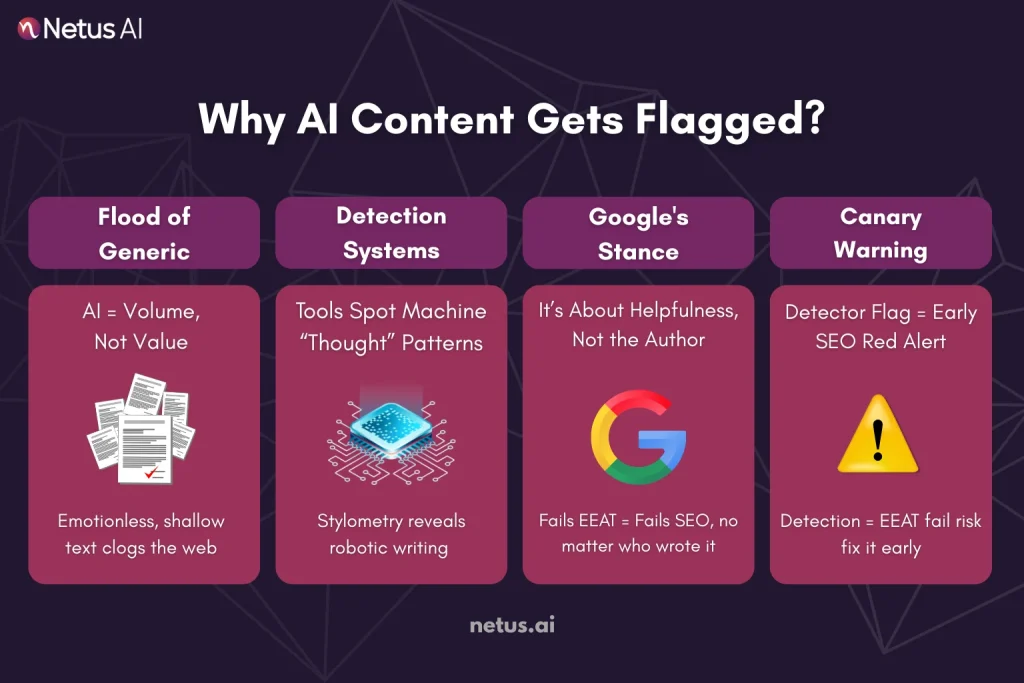
The proliferation of AI writing tools created a paradox. While they democratized content creation, they also lowered the barrier to producing vast quantities of passable, yet profoundly generic, text. The internet began to swell with articles that were structurally sound but emotionally hollow, informative on the surface but lacking in depth. This directly contradicted Google’s mission to organize the world’s information and make it universally useful and accessible. “Useful” is the operative word. A wall of synthetically generated text, even if factually correct, is not inherently useful if it lacks insight, perspective or a relatable voice.
This is where AI detection test platforms emerged not as villains but as necessary arbiters of quality. They are the technological immune response to the virus of homogeneity. Tools like GPTZero use sophisticated machine learning models trained on mountains of both human and AI-generated text. They don’t just look for plagiarism; they look for the digital fingerprint of a machine’s thought process.
Google itself, while claiming not to penalize content solely for its AI origin, is deeply invested in this same principle. Their entire Helpful Content Update and EEAT framework is a human-centric philosophy. AI content detectors are simply the practical tools that can identify content that fails this philosophy. They analyze the stylistic hallmarks that betray a lack of human experience and expertise, the very pillars of EEAT. When Google emphasizes “content written by people, for people,” it is implicitly endorsing the values these detectors are built to identify. A positive flag from a detection tool is a strong indicator that your content may also be failing Google’s qualitative, human-centric tests. It’s a canary in the coal mine for poor EEAT signals, warning you that your content, while perhaps technically “correct,” is unlikely to be seen as authoritative or trustworthy by either users or algorithms. Ignoring this warning is a significant risk in the modern SEO landscape.
Decoding the Detectives: What The Algorithms Are Actually Hunting
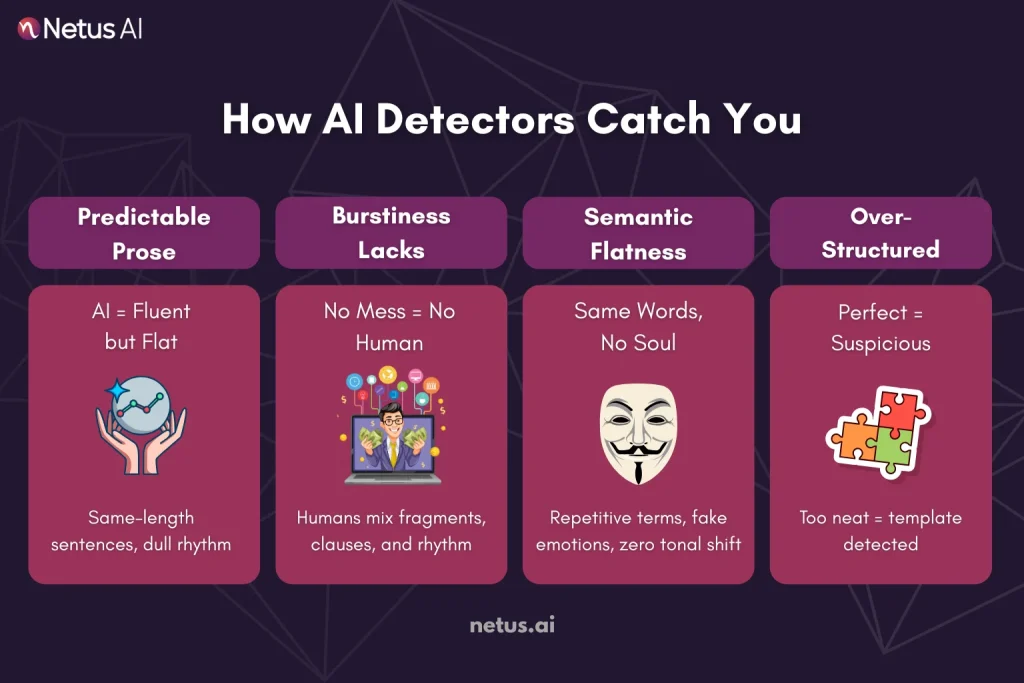
To pass AI detectors, you must first understand what they’re looking for. They aren’t magical boxes; they are pattern recognition engines. Their analysis, often called stylometry, focuses on the statistical and linguistic patterns that statistically differentiate human writing from AI writing. It’s a forensic analysis of prose.
The most significant giveaway is predictability. AI language models operate by predicting the next most statistically probable word in a sequence. While this produces fluent text, it often avoids the creative, slightly unexpected or idiosyncratic word choices a human makes. This leads to a uniformity in sentence length and structure. An AI-generated paragraph might contain sentences that are all roughly the same length and follow a similar subject-verb-object pattern, creating a rhythmic but monotonous cadence. Human writing is messier, more dynamic. We use fragments for emphasis. We craft long, flowing sentences full of clauses alongside short, punchy ones. This variation, known as “burstiness,” is a key marker of human authorship.
Beyond sentence structure, detectors analyze semantic and emotional layers. A lack of emotional flow and semantic variation is a major red flag. AI can mimic emotion but it often does so in a clichéd or inconsistent way. The tone might be uniformly upbeat or neutrally formal throughout an entire piece, lacking the subtle shifts in emotion, conviction or skepticism that a human expert naturally conveys when passionate about a subject. Similarly, humans naturally vary their vocabulary, using synonyms and metaphors to avoid repetition. AI might latch onto a specific set of words related to a topic and overuse them, lacking the nuanced understanding of when to use a more precise or creative term.
Finally, detectors look for structure-level red flags. This is where the content feels “too polished or too perfect.” An AI-generated article might have an introduction, three body points and a conclusion that are all perfectly balanced and logically sequenced but it lacks the narrative arc, the tangential yet valuable aside or the personal anecdote that gives it soul. The transitions between paragraphs might be formulaic (“Furthermore,” “On the other hand,” “In conclusion”). The overall structure can feel like a perfect, sterile template, which it often is. Human writing has fingerprints: it might dwell a little too long on a point we find fascinating, include a relevant personal story or use a conversational transition that breaks the formal rules but builds connection. It’s these imperfections that detectors have learned to see as signs of authenticity.
The Cardinal Sins: Common Mistakes That Scream "AI-Written"
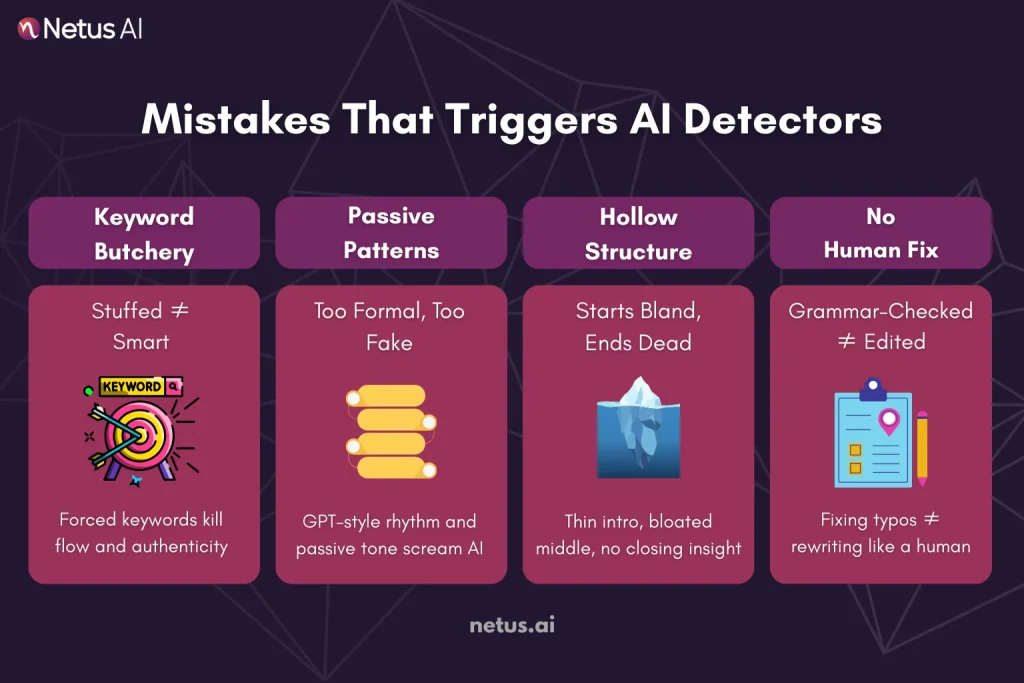
Many well-intentioned SEO writer professionals accidentally trigger these detectors not out of malice but out of a misunderstanding of how to properly refine AI output. They make simple but critical mistakes that align their content perfectly with the patterns detectors are trained to find.
The most common error is keyword dumping without narrative. This is an old SEO sin amplified by AI. The writer gets a raw AI draft and simply goes through to manually stuff in exact-match keywords or their clumsy synonyms, disrupting the natural flow of the text. The result is robotic writing that feels jarring and inorganic. Instead of a cohesive narrative that incorporates keywords contextually, the article becomes a disjointed collection of phrases forced to include specific terms. This butchery of language is easily spotted by detectors, as it combines the unnatural phrasing of human keyword-stuffing with the underlying synthetic pattern of the AI base draft.
Another major trigger is the overuse of passive voice or classic “GPT-like” sentence flow. Many AI models have a discernible rhythm and a tendency to structure sentences in a certain way. They might overuse the passive voice (“It can be seen that.”) to sound more formal or they might default to a certain cadence that becomes recognizable once you know what to look for. A human editor who merely proofreads for grammar and spelling might leave these underlying structural patterns completely intact. The sentence-level grammar is perfect but the paragraph-level music is completely synthetic. Without actively restructuring sentences, changing their opening words and varying their length, the AI’s core fingerprint remains untouched.
Finally, there is the tell-tale structural giveaway of thin intros, bloated middles and flat endings. A generic AI introduction might start with a broad, obvious statement about the importance of a topic before stating what the article will cover in a bland, predictable way. The body sections might be bloated with definitions and surface-level explanations that lack depth or unique insight, perfectly mirroring the most common information found on the internet. The conclusion will often summarise the points just made without offering any new perspective, actionable next steps or a compelling thought to leave with the reader. This cookie-cutter structure, devoid of the depth that comes from real expertise, is a blueprint for getting your AI content flagged. It signals a lack of original thought and a heavy reliance on aggregated, common knowledge, the antithesis of EEAT.
The path forward isn’t to abandon AI but to become a better editor, a more insightful curator and a more authentic voice. It’s about using the tool for what it’s best at, drafting, ideation and structure and then applying the human touch for what we are best at: depth, nuance, story and soul. The next section will detail the practical workflow to transform detected AI content into authentic, EEAT-rich writing that both algorithms and humans will love.
Content Starts at Generation: NetusAI’s SEO Article Writer and Content Generator
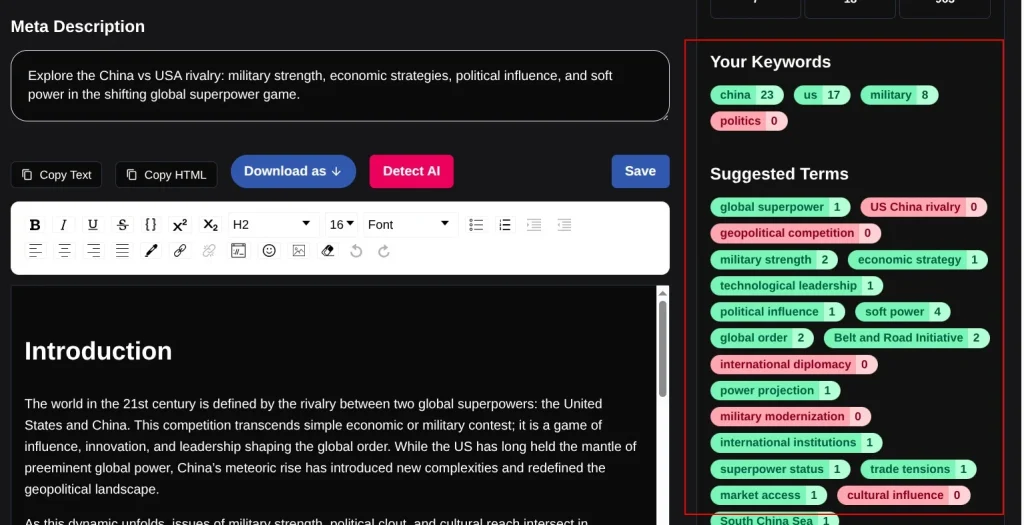
Avoiding stylometry and detection issues shouldn’t begin after content is written, it should start with the writing itself. That’s where NetusAI steps in.
Unlike generic AI tools that churn out robotic, easily flagged paragraphs, The NetusAI SEO Article Generator is designed to help you create full-length blog posts that are already optimized for clarity, tone and search intent. Unlike generic tools, it goes beyond simple drafting. It:
- Lets you input headlines and targeted SEO keywords
- Supports long-form templates for full blogs
- Auto-generates a structure with Title → Outline → Content
- Works in multiple languages for global teams
And most importantly: it ties directly into the Netus AI Bypasser + Detector system, meaning your output isn’t just readable, it’s already tuned to avoid detection.
You can generate, review and rewrite all in one interface without needing third-party tools to patch the gaps. It’s built for marketers, freelancers and bloggers who want their AI content to actually pass as human-written.
Final Thoughts
Passing AI detection tests isn’t just about fooling a scanner , it’s about delivering content that feels human, connects with readers and satisfies Google’s quality standards. As AI becomes more integrated into the writing process, stylometry and detection tools will only get stricter.
Smart SEO writers will adapt , not by ditching AI but by using smarter tools like Netus to rewrite, restructure and humanize content at scale. The future of SEO writing belongs to those who blend AI efficiency with human nuance.
FAQs
They analyze text patterns like repetition, predictability and sentence structure. Tools like GPTZero and Originality.ai look for signs of machine-generated writing such as uniform tone, unnatural flow and lack of variation.
Yes, but not just because it’s AI-written. Google penalizes content that lacks value, originality and EEAT signals. Poorly written AI content often triggers these flags.
You need to rewrite your content using tools like Netus, which offers real-time detection + paraphrasing to help restructure your writing in a more human tone.
No. Even well-crafted prompts still result in stylometry patterns that detectors can catch. Humanizing your output through rewriting is essential.
Stylometry is the analysis of writing style. It compares your content’s tone, rhythm and structure to known human benchmarks. If your text is too consistent or robotic, it gets flagged.
Netus offers:
- An AI Bypasser Engine that rewrites text to avoid detection
- A built-in AI Detector to test outputs instantly
- A Paraphraser optimized for SEO content rewriting
If rankings and visibility matter , yes. Always run your blog through a humanizer tool like Netus to ensure it passes detection and reads naturally.
Free tools may offer surface-level fixes but rarely handle stylometry or SEO preservation well. Netus is built specifically to rewrite long-form AI content while keeping SEO intact.
SEO blogs, academic writing and affiliate pages are often flagged due to predictable structure, keyword overuse and shallow intros or conclusions.



